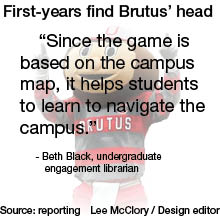Brutus Buckeye has lost his head and he needs help finding it.
At least, that’s the premise of a game called Head Hunt for first-years on campus — the Scarlet and Gray mascot is enlisting those students’ help to locate his missing head in an effort to get them familiarized with Ohio State’s library system and campus.
The hunt takes place through an online game that offers first-years a virtual journey of campus in a quest seeking the Buckeye’s missing head.
“Since the game is based on the campus map, it helps students to learn to navigate the campus,” said Beth Black, an undergraduate engagement librarian and main contact for the game. “Our goals in developing Head Hunt were to provide an orientation to library resources and services for incoming students in order to alleviate fears and encourage usage,” she said.
The overall game consists of an interactive campus map, games and short videos.
The first game was launched in fall 2007 to nearly 6,000 first-years, according to the game’s website.
This year, all first-year students received an email explaining how the game works before classes start and have until Oct. 31 to complete the game. If completed on time, students are eligible to win a $50 Barnes & Noble gift card. Ten gift cards will be awarded, according to the website, but participation is not mandatory.
Although Black said she couldn’t find an exact cost of the game, she said the cost is “minimal.” She said the only recurring cost of the game is $500 for prizes.
Some students said they think the game might be helpful for becoming more familiar with campus.
“As first-years, many of us are unfamiliar with campus,” said Kylee Voshel, a first-year in international studies who hasn’t played the game. “Head Hunt would be a great resource for learning about the library system while meeting new people.”
She said turning a somewhat-boring library experience into a game is a good way to get students involved and help them learn about the library’s services.
“A lot of students only want to use online sources because it’s easier and because they are unfamiliar with the library system,” she said.
Samantha Norman, a first-year in agriscience education, said she likes the game’s motive but doesn’t think it would be of much use to her.
“I feel as though I already have a good idea of how the library and its resources work,” she said.
Karen Diaz, an instructional librarian on the original design team, said the game was developed on the quarter system and it was a great way to engage students before they came to campus.
“We have learned that in the semester system, the game really does not get played before people come to campus, so we are now promoting it heavily through Welcome Week and survey classes,” Diaz said.
So far, the game has been effective, Black said.
“We did surveys of students in 2006, prior to the game, as a baseline, and again in 2007 and 2008 with students who played Head Hunt,” she said. “We found an increase in library usage and a decrease in students who reported that the library was imposing.”
Last year, 153 students played the game during the prize eligibility period, Black said.
So far, 2009 saw the most participants with 816.



